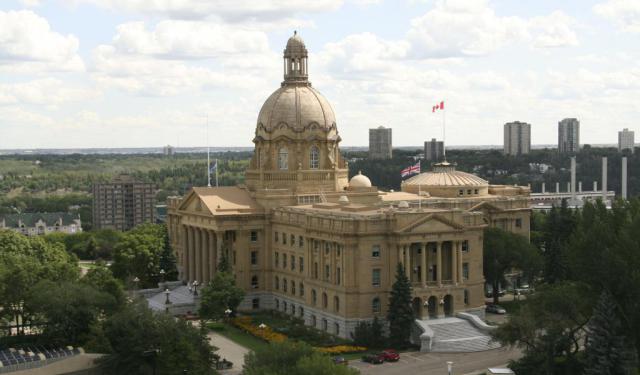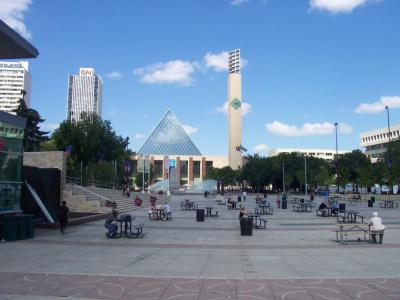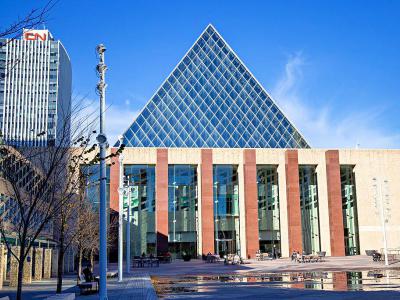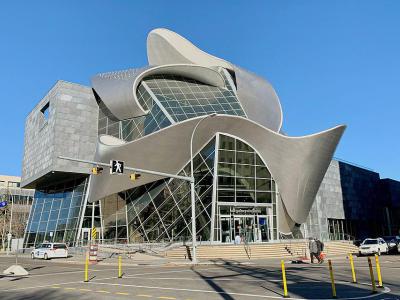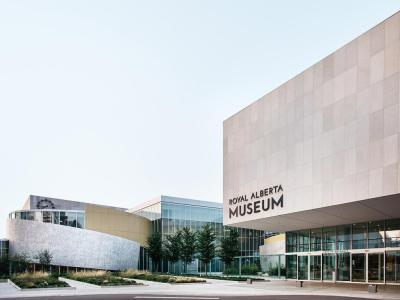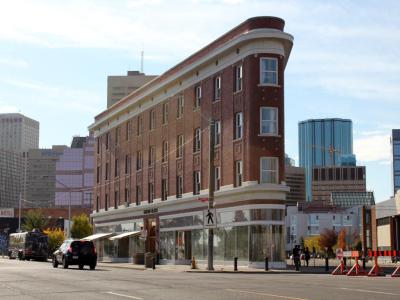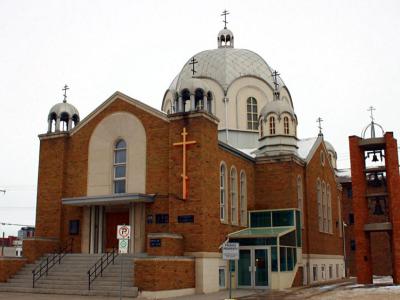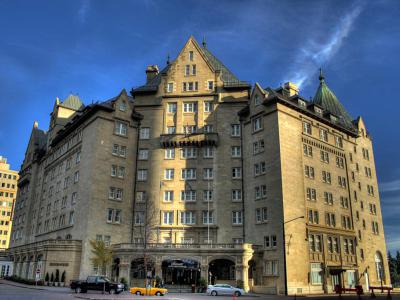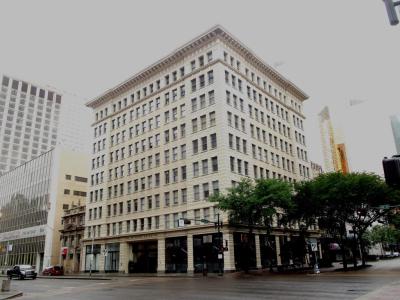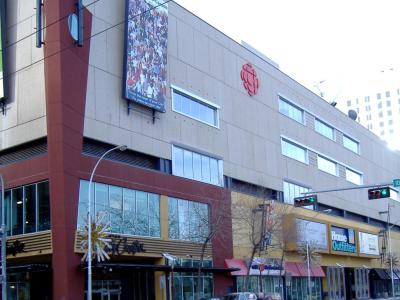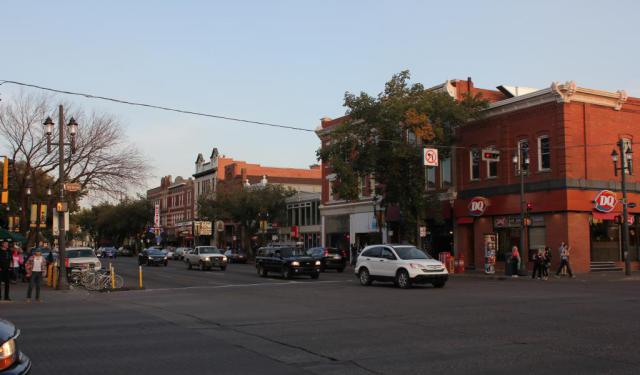Edmonton Introduction Walking Tour (Self Guided), Edmonton
Nicknamed "Canada's Festival City" for its year-round slate of festivals, Edmonton – the capital city of Alberta province – is a cultural, governmental, and educational hub. It is also known as the "City of Champions," the moniker coined by the mayor of the city who praised the community's resilient response to F4 tornado that struck Edmonton in July 1987.
Fort Edmonton, established by the Hudson's Bay Company (HBC) in 1795, marked the first permanent European settlement in the area. Named after Edmonton, Middlesex, the English hometown of some influential HBC members, the fort was a strategic point in the fur trade, pivotal for the company's operations against its rival, the North West Company.
The area around Edmonton, rich in resources (abundant fish, medicinal plants, and tool-making materials like chert), had been originally inhabited by First Nations such as the Cree, Nakota Sioux, and Blackfoot, for thousands of years. European interest in the region was sparked by English expeditions in 1754 as part of the HBC's efforts to cement fur trading alliances with the local indigenous populations.
The signing of Treaty 6 in 1876 between First Nations and the British Crown was a significant milestone, formalizing the use of the land for settlement. Edmonton's growth was further fueled by the arrival of the Canadian Pacific Railway in 1885 and the Calgary and Edmonton Railway in 1891, transforming the region into a crucial agricultural and commercial center. Edmonton was incorporated first as a town in 1892 and then as a city in 1904, becoming the capital of the newly formed province of Alberta in 1905.
This period of expansion was marked by rapid population growth, real estate speculation, and significant urban development, which continued through the early 20th century, establishing Edmonton as a major northern metropolis and "Gateway to the North." Notable sites of that era include the historic Hotel Macdonald, opened in 1915, offering a glimpse of the city's early 20th-century grandeur, and the McLeod Building, constructed in 1915 as the city’s first skyscraper.
Among the city's other key landmarks are the Royal Alberta Museum reflecting the region's aboriginal culture and natural history, the futuristic-looking Art Gallery of Alberta, renowned for its First Nations art, and more.
Edmonton offers a blend of historical richness and contemporary dynamism, inviting visitors to explore its streets, museums, and historical sites. So, come and experience the unique charm of Alberta’s capital firsthand on this self-guided walk to discover Edmonton’s past and enjoy its present!
Fort Edmonton, established by the Hudson's Bay Company (HBC) in 1795, marked the first permanent European settlement in the area. Named after Edmonton, Middlesex, the English hometown of some influential HBC members, the fort was a strategic point in the fur trade, pivotal for the company's operations against its rival, the North West Company.
The area around Edmonton, rich in resources (abundant fish, medicinal plants, and tool-making materials like chert), had been originally inhabited by First Nations such as the Cree, Nakota Sioux, and Blackfoot, for thousands of years. European interest in the region was sparked by English expeditions in 1754 as part of the HBC's efforts to cement fur trading alliances with the local indigenous populations.
The signing of Treaty 6 in 1876 between First Nations and the British Crown was a significant milestone, formalizing the use of the land for settlement. Edmonton's growth was further fueled by the arrival of the Canadian Pacific Railway in 1885 and the Calgary and Edmonton Railway in 1891, transforming the region into a crucial agricultural and commercial center. Edmonton was incorporated first as a town in 1892 and then as a city in 1904, becoming the capital of the newly formed province of Alberta in 1905.
This period of expansion was marked by rapid population growth, real estate speculation, and significant urban development, which continued through the early 20th century, establishing Edmonton as a major northern metropolis and "Gateway to the North." Notable sites of that era include the historic Hotel Macdonald, opened in 1915, offering a glimpse of the city's early 20th-century grandeur, and the McLeod Building, constructed in 1915 as the city’s first skyscraper.
Among the city's other key landmarks are the Royal Alberta Museum reflecting the region's aboriginal culture and natural history, the futuristic-looking Art Gallery of Alberta, renowned for its First Nations art, and more.
Edmonton offers a blend of historical richness and contemporary dynamism, inviting visitors to explore its streets, museums, and historical sites. So, come and experience the unique charm of Alberta’s capital firsthand on this self-guided walk to discover Edmonton’s past and enjoy its present!
How it works: Download the app "GPSmyCity: Walks in 1K+ Cities" from Apple App Store or Google Play Store to your mobile phone or tablet. The app turns your mobile device into a personal tour guide and its built-in GPS navigation functions guide you from one tour stop to next. The app works offline, so no data plan is needed when traveling abroad.
Edmonton Introduction Walking Tour Map
Guide Name: Edmonton Introduction Walking Tour
Guide Location: Canada » Edmonton (See other walking tours in Edmonton)
Guide Type: Self-guided Walking Tour (Sightseeing)
# of Attractions: 9
Tour Duration: 1 Hour(s)
Travel Distance: 2.2 Km or 1.4 Miles
Author: ChristineS
Sight(s) Featured in This Guide:
Guide Location: Canada » Edmonton (See other walking tours in Edmonton)
Guide Type: Self-guided Walking Tour (Sightseeing)
# of Attractions: 9
Tour Duration: 1 Hour(s)
Travel Distance: 2.2 Km or 1.4 Miles
Author: ChristineS
Sight(s) Featured in This Guide:
- Churchill Square
- Edmonton City Hall
- Art Gallery Of Alberta
- Royal Alberta Museum
- Boyle Street and Gibson Block
- St. Barbara’s Russian Orthodox Cathedral
- Hotel Macdonald
- McLeod Building
- Edmonton City Centre Mall
1) Churchill Square
Sir Winston Churchill Square, commonly known as Churchill Square, is the vibrant heart of downtown Edmonton. This bustling urban plaza is renowned for hosting a diverse array of festivals and events that draw locals and visitors alike. Among the notable events are the Edmonton International Street Performers Festival, Edmonton Fashion Week, The Works Art & Design Festival, Taste of Edmonton, Cariwest, and the annual Pride Festival. These events transform the square into a lively hub of cultural expression and community engagement, showcasing the city's rich artistic and multicultural heritage.
The square is strategically surrounded by several of Edmonton's key cultural and governmental landmarks. To the north lies Edmonton City Hall, while the Law Courts and the Art Gallery of Alberta are situated to the northeast. The east side of the square is home to Chancery Hall and the Francis Winspear Centre for Music, and the southeast corner features the Citadel Theatre. The south is anchored by the Stanley A. Milner Library, and to the west, the Edmonton City Centre mall provides additional commercial amenities. This concentration of significant buildings makes Churchill Square not only a cultural epicenter but also a convenient and accessible gathering place for Edmontonians.
Churchill Square is designed to be a safe, family-friendly, and lively urban plaza. It offers a variety of pavilions, public art installations, water features, and seating areas that invite relaxation and social interaction. The square's layout and amenities are intended to foster a vibrant public space where people can gather, enjoy performances, or simply unwind. During the warmer months, the Churchill Square Lunch Truck Program adds to the square's appeal, offering a range of food options on weekdays, and often extending into weekends during major festivals and events.
The square's active calendar of events and its proximity to significant cultural institutions make it an essential part of Edmonton's downtown experience.
The square is strategically surrounded by several of Edmonton's key cultural and governmental landmarks. To the north lies Edmonton City Hall, while the Law Courts and the Art Gallery of Alberta are situated to the northeast. The east side of the square is home to Chancery Hall and the Francis Winspear Centre for Music, and the southeast corner features the Citadel Theatre. The south is anchored by the Stanley A. Milner Library, and to the west, the Edmonton City Centre mall provides additional commercial amenities. This concentration of significant buildings makes Churchill Square not only a cultural epicenter but also a convenient and accessible gathering place for Edmontonians.
Churchill Square is designed to be a safe, family-friendly, and lively urban plaza. It offers a variety of pavilions, public art installations, water features, and seating areas that invite relaxation and social interaction. The square's layout and amenities are intended to foster a vibrant public space where people can gather, enjoy performances, or simply unwind. During the warmer months, the Churchill Square Lunch Truck Program adds to the square's appeal, offering a range of food options on weekdays, and often extending into weekends during major festivals and events.
The square's active calendar of events and its proximity to significant cultural institutions make it an essential part of Edmonton's downtown experience.
2) Edmonton City Hall
Edmonton's City Hall, designed by Dub Architects and completed in 1992, is an iconic structure in downtown Edmonton. The building is characterized by its two prominent steel and glass pyramids, one reaching 43 meters from ground to peak, atop a three-story concrete base. These pyramids are not merely aesthetic features; they also serve functional purposes by providing natural light to the main atrium and the council chambers. Complementing these pyramids is a striking 200-foot clock tower, which is crowned with a 25-bell carillon, adding both visual and auditory elements to the city's skyline.
The design process of Edmonton's City Hall was not without its challenges and controversies. Initially, the architects proposed a design featuring five cones, intended to pay homage to the tipis traditionally used by the First Nations people who originally inhabited the area. However, this design received significant backlash from the public and media, who derisively nicknamed it "the Cone Dome." In response to the public's reaction, Dub Architects revised their plans, replacing the cones with the now-celebrated pyramids. This new design was much better received, earning the nickname "Pyramid Power" and gaining appreciation for its modern yet respectful nod to the city's heritage.
The completed City Hall has become a landmark in Edmonton, symbolizing both the city's history and its forward-looking spirit. The pyramids, aside from their practical function, also stand as a visual metaphor for transparency and openness in governance. The carillon in the clock tower adds a traditional element, with its bells often heard chiming across the city center, providing a harmonious blend of old and new.
The building continues to serve as a central hub for city administration and a proud symbol for the residents of Edmonton.
The design process of Edmonton's City Hall was not without its challenges and controversies. Initially, the architects proposed a design featuring five cones, intended to pay homage to the tipis traditionally used by the First Nations people who originally inhabited the area. However, this design received significant backlash from the public and media, who derisively nicknamed it "the Cone Dome." In response to the public's reaction, Dub Architects revised their plans, replacing the cones with the now-celebrated pyramids. This new design was much better received, earning the nickname "Pyramid Power" and gaining appreciation for its modern yet respectful nod to the city's heritage.
The completed City Hall has become a landmark in Edmonton, symbolizing both the city's history and its forward-looking spirit. The pyramids, aside from their practical function, also stand as a visual metaphor for transparency and openness in governance. The carillon in the clock tower adds a traditional element, with its bells often heard chiming across the city center, providing a harmonious blend of old and new.
The building continues to serve as a central hub for city administration and a proud symbol for the residents of Edmonton.
3) Art Gallery Of Alberta
The Art Gallery of Alberta (AGA) is a prominent public art gallery located in downtown Edmonton. It houses a vast collection of over 6,000 works of art, encompassing historical and contemporary paintings, sculptures, installations, and photographs by both Canadian and international artists. The gallery not only boasts a substantial permanent collection but also hosts a variety of visiting exhibitions and offers extensive public education programs. The AGA's vision is to create a welcoming and engaging environment that inspires people to transform their understanding of the world through connections with visual arts.
Originally designed in 1968 by architect Don Bittorf, the AGA was conceived as a Brutalist structure. This distinctive building underwent a significant transformation with an $88 million renovation led by Randall Stout Architects. The renovation, completed in 2010, expanded the gallery's space to 85,000 square feet, nearly doubling the exhibition area. The redesign included the addition of a restaurant, a gallery shop, a 150-seat theatre, and dedicated gallery space for the AGA's permanent collection. The revamped facility was officially reopened to the public on January 31, 2010.
The AGA continues to thrive as a dynamic hub for art and culture in Edmonton, reflecting its commitment to enriching the community's understanding and appreciation of visual arts.
Originally designed in 1968 by architect Don Bittorf, the AGA was conceived as a Brutalist structure. This distinctive building underwent a significant transformation with an $88 million renovation led by Randall Stout Architects. The renovation, completed in 2010, expanded the gallery's space to 85,000 square feet, nearly doubling the exhibition area. The redesign included the addition of a restaurant, a gallery shop, a 150-seat theatre, and dedicated gallery space for the AGA's permanent collection. The revamped facility was officially reopened to the public on January 31, 2010.
The AGA continues to thrive as a dynamic hub for art and culture in Edmonton, reflecting its commitment to enriching the community's understanding and appreciation of visual arts.
4) Royal Alberta Museum (must see)
The Royal Alberta Museum (RAM) is the largest museum in Western Canada and one of the premier cultural institutions in the country. Located in the vibrant Arts District of downtown Edmonton, the museum is dedicated to collecting, preserving, researching, interpreting, and exhibiting objects and specimens that highlight the rich heritage of Alberta's people and its natural environment.
Originally known as the Provincial Museum of Alberta, the institution received its current name on May 24, 2005, when Queen Elizabeth II granted it royal patronage during her visit.
The Royal Alberta Museum boasts three permanent galleries that draw visitors year-round: Wild Alberta, the Syncrude Gallery of Aboriginal Culture, and the Natural History gallery. Each of these galleries offers an immersive experience into different facets of Alberta's heritage and environment. Wild Alberta showcases the province's diverse ecosystems and wildlife, while the Syncrude Gallery of Aboriginal Culture provides deep insights into the history and contributions of Indigenous peoples. The Natural History gallery features fascinating displays of the region's geological and biological diversity.
In addition to its permanent exhibits, the RAM hosts rotating galleries that welcome travelling exhibitions from around the world, as well as those curated in-house by the museum's own team. Alongside the museum, the premises include Government House, which serves as a venue for the Alberta Government Caucus, adding another layer of historical and governmental significance to the site.
Originally known as the Provincial Museum of Alberta, the institution received its current name on May 24, 2005, when Queen Elizabeth II granted it royal patronage during her visit.
The Royal Alberta Museum boasts three permanent galleries that draw visitors year-round: Wild Alberta, the Syncrude Gallery of Aboriginal Culture, and the Natural History gallery. Each of these galleries offers an immersive experience into different facets of Alberta's heritage and environment. Wild Alberta showcases the province's diverse ecosystems and wildlife, while the Syncrude Gallery of Aboriginal Culture provides deep insights into the history and contributions of Indigenous peoples. The Natural History gallery features fascinating displays of the region's geological and biological diversity.
In addition to its permanent exhibits, the RAM hosts rotating galleries that welcome travelling exhibitions from around the world, as well as those curated in-house by the museum's own team. Alongside the museum, the premises include Government House, which serves as a venue for the Alberta Government Caucus, adding another layer of historical and governmental significance to the site.
5) Boyle Street and Gibson Block
Boyle Street is a historic neighborhood, located immediately east of the downtown core. Named after lawyer John Robert Boyle, the area holds the distinction of being one of Edmonton's oldest parts. Originally, Boyle Street served as the city's downtown before the current downtown area developed on land sold by the Hudson's Bay Company. This neighborhood has a rich history, reflected in its dense concentration of old buildings and heritage sites.
During the 1970s, many buildings in Boyle Street were demolished as the city undertook efforts to remove derelict housing and redevelop the area. However, several structures survived this wave of destruction, largely due to their Edwardian architectural styles or heritage designations. Among these, the Gibson Block stands out as a distinctive municipal historic resource.
The Gibson Block is a rare example of a commercial building modeled after the 1902 prototype of a flatiron building, known for its triangular shape. This architectural style, originating in New York, was popular in North American cities before World War One as a practical solution for utilizing oddly-shaped parcels of real estate. Developed by William Gibson, it is also notable for its incorporation of Chicago-style architectural elements. This includes the vertical emphasis of pilasters and windows contrasted with horizontal motifs in continuous glass shop fronts and cornices.
Originally, the Gibson Block housed retail space on its first floor, offices on the upper floors, and even a Turkish Baths in the basement. However, in 1914, the upper floors were converted to apartments, reflecting the evolving needs and dynamics of the city's population.
During the 1970s, many buildings in Boyle Street were demolished as the city undertook efforts to remove derelict housing and redevelop the area. However, several structures survived this wave of destruction, largely due to their Edwardian architectural styles or heritage designations. Among these, the Gibson Block stands out as a distinctive municipal historic resource.
The Gibson Block is a rare example of a commercial building modeled after the 1902 prototype of a flatiron building, known for its triangular shape. This architectural style, originating in New York, was popular in North American cities before World War One as a practical solution for utilizing oddly-shaped parcels of real estate. Developed by William Gibson, it is also notable for its incorporation of Chicago-style architectural elements. This includes the vertical emphasis of pilasters and windows contrasted with horizontal motifs in continuous glass shop fronts and cornices.
Originally, the Gibson Block housed retail space on its first floor, offices on the upper floors, and even a Turkish Baths in the basement. However, in 1914, the upper floors were converted to apartments, reflecting the evolving needs and dynamics of the city's population.
6) St. Barbara’s Russian Orthodox Cathedral
Saint Barbara’s Russian Orthodox Cathedral is as one of the 25 parishes of the Moscow Patriarchate in Canada. The presence of the Russian Orthodox Church in Edmonton dates back to 1897 when the first Russian Orthodox missionaries arrived via Alaska. The inaugural Russian Orthodox liturgy in the region occurred 122 years ago in Wostok, a community 50 miles northeast of Edmonton.
The first liturgies of Saint Barbara’s were held in 1902 in a modest frame house on the current cathedral's site. By 1908, a wooden church had been constructed, which was eventually replaced by the existing cathedral completed in 1958. Today, Saint Barbara’s boasts a membership of about 250 individuals. The services, known as liturgies, are conducted in a mixture of English and Russian to accommodate both recent immigrants and long-established members, some of whom are second, third, or even fourth-generation Canadians.
Architecturally, the cathedral is notable for its cross-shaped design and the numerous cupolas adorning its roof. Inside, it features a richly decorated altar and a specially constructed iconostasis, or screen, where sacred icons are displayed.
The first liturgies of Saint Barbara’s were held in 1902 in a modest frame house on the current cathedral's site. By 1908, a wooden church had been constructed, which was eventually replaced by the existing cathedral completed in 1958. Today, Saint Barbara’s boasts a membership of about 250 individuals. The services, known as liturgies, are conducted in a mixture of English and Russian to accommodate both recent immigrants and long-established members, some of whom are second, third, or even fourth-generation Canadians.
Architecturally, the cathedral is notable for its cross-shaped design and the numerous cupolas adorning its roof. Inside, it features a richly decorated altar and a specially constructed iconostasis, or screen, where sacred icons are displayed.
7) Hotel Macdonald
The Fairmont Hotel Macdonald, commonly known as "The Mac," is a storied luxury hotel. Situated at the eastern end of downtown Edmonton, the hotel boasts a prime location overlooking the North Saskatchewan River. Standing 47.7 meters (156 feet) tall, this eleven-story hotel was designed by the Canadian architectural firm Ross and MacFarlane. It is named after Sir John A. Macdonald, Canada's first prime minister, and opened its doors on July 5, 1915.
Constructed by the Grand Trunk Pacific Railway Company as part of Canada's grand railway hotels network, the Hotel Macdonald is an exemplary model of Châteauesque architecture, a style inspired by French Renaissance chateaux. The building's design features pitched sloped dormered roofs adorned with chimneys, finials, and turrets, with entryways placed diagonally and flanked by perpendicular wings and turret towers. The L-shaped hotel is crowned with a copper roof, contributing to its distinctive historical charm.
The exterior facade of the Hotel Macdonald is clad in Indiana limestone and is richly detailed with architectural elements such as balustrades, balconettes, brackets, cornices, hood mouldings, and overhangs. The main portico features five arches supported by four pillars and two pilasters, which are intricately decorated with gargoyles and the provincial crests of the four western Canadian provinces. These features, along with the building's limestone facade and copper roofing, were designated as a "municipal historic resource" on November 27, 1984, under the provincial Historic Resources Act.
Following the bankruptcy of the Grand Trunk in 1919, the hotel's management was taken over by Canadian National Hotels. Over the years, the building underwent several renovations and expansions, including a new wing added in 1953. However, the expansion wing was demolished in 1983 when Canadian National Hotels ceased operations. The property was sold to Canadian Pacific Hotels in 1988, which restored and reopened the hotel in May 1991.
Constructed by the Grand Trunk Pacific Railway Company as part of Canada's grand railway hotels network, the Hotel Macdonald is an exemplary model of Châteauesque architecture, a style inspired by French Renaissance chateaux. The building's design features pitched sloped dormered roofs adorned with chimneys, finials, and turrets, with entryways placed diagonally and flanked by perpendicular wings and turret towers. The L-shaped hotel is crowned with a copper roof, contributing to its distinctive historical charm.
The exterior facade of the Hotel Macdonald is clad in Indiana limestone and is richly detailed with architectural elements such as balustrades, balconettes, brackets, cornices, hood mouldings, and overhangs. The main portico features five arches supported by four pillars and two pilasters, which are intricately decorated with gargoyles and the provincial crests of the four western Canadian provinces. These features, along with the building's limestone facade and copper roofing, were designated as a "municipal historic resource" on November 27, 1984, under the provincial Historic Resources Act.
Following the bankruptcy of the Grand Trunk in 1919, the hotel's management was taken over by Canadian National Hotels. Over the years, the building underwent several renovations and expansions, including a new wing added in 1953. However, the expansion wing was demolished in 1983 when Canadian National Hotels ceased operations. The property was sold to Canadian Pacific Hotels in 1988, which restored and reopened the hotel in May 1991.
8) McLeod Building
The McLeod Building, a historic office edifice in Downtown Edmonton, stands as a testament to early 20th-century architectural ambition and style. Recognized for its historical significance, it was designated a Provincial Historic Resource on January 3, 1995. The building was conceived by Kenneth McLeod, a former Edmonton alderman, contractor, and real estate speculator, who ambitiously announced in 1912 that his building would be the tallest in the city, surpassing the height of the then-prominent Tegler Building by 25 feet (7.6 meters).
Designed by architect John K. Dow, the McLeod Building was modeled after the Paulsen Building in Spokane, Washington, which Dow had also designed. Construction commenced in 1913 and concluded in 1915, during a period of rapid urban growth and architectural evolution in Edmonton. Despite McLeod's claims, by the time the building was completed, the Alberta Legislature Building had already surpassed its height, reducing the impact of McLeod's initial boast. Nonetheless, the McLeod Building became a notable addition to Edmonton's skyline.
Architecturally, the McLeod Building is celebrated as Alberta's best remaining example of the Chicago School style for commercial buildings. This architectural style, characterized by its use of steel-frame construction, large windows, and minimal exterior ornamentation, was a precursor to modern skyscraper design. The building's robust and functional aesthetic, coupled with its historical context, makes it an important landmark in Edmonton's architectural heritage.
Designed by architect John K. Dow, the McLeod Building was modeled after the Paulsen Building in Spokane, Washington, which Dow had also designed. Construction commenced in 1913 and concluded in 1915, during a period of rapid urban growth and architectural evolution in Edmonton. Despite McLeod's claims, by the time the building was completed, the Alberta Legislature Building had already surpassed its height, reducing the impact of McLeod's initial boast. Nonetheless, the McLeod Building became a notable addition to Edmonton's skyline.
Architecturally, the McLeod Building is celebrated as Alberta's best remaining example of the Chicago School style for commercial buildings. This architectural style, characterized by its use of steel-frame construction, large windows, and minimal exterior ornamentation, was a precursor to modern skyscraper design. The building's robust and functional aesthetic, coupled with its historical context, makes it an important landmark in Edmonton's architectural heritage.
9) Edmonton City Centre Mall
Edmonton City Centre Mall, situated in the heart of downtown Edmonton, serves as a bustling urban shopping hub with an array of offerings to suit a variety of tastes and needs. This two-story shopping centre is home to over 170 stores and services, including upscale boutiques and unique dining options, ensuring that visitors have plenty of choices for shopping, dining, and entertainment. The mall’s recent renovations have added a modern touch, enhancing its appeal and comfort for shoppers.
One of the highlights of Edmonton City Centre Mall is the freshly renovated ELEVATE food fare, which provides a wide range of tasty dining options. Whether you are looking for a quick snack or a full meal, ELEVATE offers a variety of culinary delights that can recharge you for more shopping. The mall also boasts a Landmark Cinema, which is known for its short lineups, making it a convenient spot to catch the latest movies without the long waits often found at other theaters.
Additionally, the mall offers underground parking, providing a hassle-free parking solution for those who prefer to drive. These features make the mall not only a popular shopping destination but also a practical choice for downtown visitors.
One of the highlights of Edmonton City Centre Mall is the freshly renovated ELEVATE food fare, which provides a wide range of tasty dining options. Whether you are looking for a quick snack or a full meal, ELEVATE offers a variety of culinary delights that can recharge you for more shopping. The mall also boasts a Landmark Cinema, which is known for its short lineups, making it a convenient spot to catch the latest movies without the long waits often found at other theaters.
Additionally, the mall offers underground parking, providing a hassle-free parking solution for those who prefer to drive. These features make the mall not only a popular shopping destination but also a practical choice for downtown visitors.
Walking Tours in Edmonton, Alberta
Create Your Own Walk in Edmonton
Creating your own self-guided walk in Edmonton is easy and fun. Choose the city attractions that you want to see and a walk route map will be created just for you. You can even set your hotel as the start point of the walk.
Old Strathcona Walking Tour
Old Strathcona, located in south-central Edmonton, Alberta, is a historic and vibrant district. Once the commercial core of the separate city of Strathcona, it is now a major arts and entertainment hub frequented by residents and students from the nearby University of Alberta, making it a unique and essential part of Edmonton's identity.
The Strathcona Public Building and the iconic... view more
Tour Duration: 2 Hour(s)
Travel Distance: 2.7 Km or 1.7 Miles
The Strathcona Public Building and the iconic... view more
Tour Duration: 2 Hour(s)
Travel Distance: 2.7 Km or 1.7 Miles
The Most Popular Cities
/ view all
